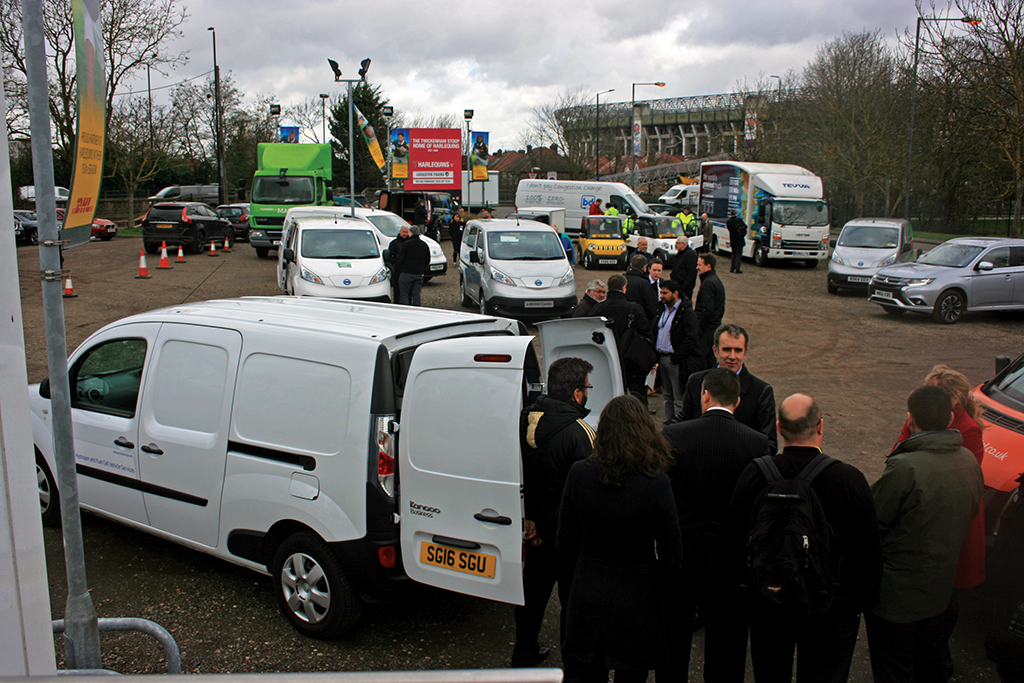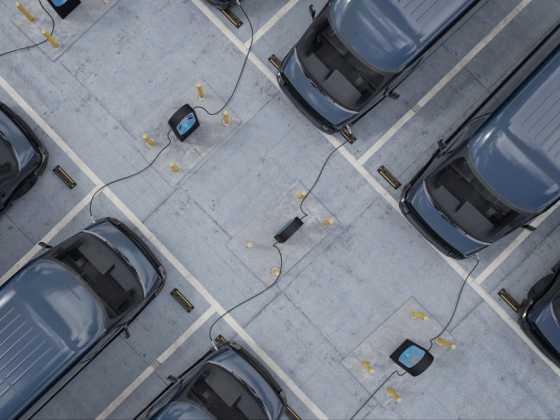The alternative route for commercials

Transport for London’s LoCITY programme works to reduce the impact of commercial vehicles on the environment – while making sure London still gets the goods and services it needs. GreenFleet chats to programme manager Fergus Worthy to find out how HGV and van fleet operators can get support from the scheme
What is LoCITY and what has it delivered so far?
LoCITY is TfL’s low-emission commercial vehicle programme. It is reducing emissions from vans and HGVs by helping fleets switch from diesel to alternative fuels. We know there is no ‘silver bullet’ to replace diesel, so we are looking at all the options out there, such as plug-in vehicles, hydrogen and biomethane.
We’re helping fleets prepare for London’s Ultra Low Emission Zone, but many organisations are ready to take the next step and start introducing alternative fuels into their fleet.
The programme is shaped and delivered by our four industry-led working groups. The groups meet quarterly and are attended by senior fleet decision makers, vehicle manufacturers, central and local government, infrastructure providers and trade associations. They are working to overcome the barriers to fleet adoption of alternative fuels and are driving real change in the commercial vehicle market.
The LoCITY website is the best place to find out more about the programme outputs (www.LoCITY.org.uk). There are video case studies, a tool to help fleets find the right vehicle for their needs, and a map with all the places to refuel and recharge in London.
How do you get fleets interested in alternative fuels?
What we’ve learned so far is there are two key areas. The first is to give fleet decision makers and drivers hands-on experience of the vehicles. With electric vehicles for example, a lot of driver resistance goes away once they try the vehicles for themselves and find that they are quiet, easy to drive, don’t need AdBlue and so on.
Similarly with some of the other technologies, getting fleet managers to test the vehicles helps overcome misconceptions such as the vehicles not being powerful enough to do the job, or being difficult or dangerous to refuel. The second is that fleets want to hear what it’s like to run an alternatively fuelled vehicle from other organisations already using them.
Fleets don’t always trust claims from manufacturers and dealers about vehicle suitability, range, and running costs. Other organisations are more likely to give them the full story – good points and bad – so fleets can really feel they are making an informed decision.
We’ve already had some success in these areas. LoCITY’s Annual Conference in 2016 at the Guildhall had a wide range of vehicles exhibited outside, and at our working groups we have presentations from fleets using different technologies to help share best practice.
A couple of months ago we supported the hugely successful Commercial GreenFleet and LoCITY event at The Stoop in Twickenham. Electric vans were available for test drives, and fleets could also get under the bonnet of the latest gas trucks on the market.
What are the plans for 2017?
At the moment we’re involved in some really interesting work with Cenex and LowCVP to understand the whole life costs and emissions outcomes for alternative fuels for different vehicle types and duty cycles. This is well understood for electric cars and light vans, but until now this hasn’t been extended to include HGVs, or fuels like biomethane, hydrogen and HVO.
By the summer we’ll have a tool on the LoCITY website where fleets can enter information about their current fleet and requirements for a new vehicle, and get advice on which fuel would work best for them operationally, financially and environmentally.
It’s not a detailed fleet review so we don’t expect fleets to make a purchase decision just based on this tool. Instead we hope it will get organisations thinking differently about alternative fuels, and help them understand where they can work for them. It will be free to use and should work for all fleet sizes and types.
I explained earlier about the importance of giving fleets hands-on experience of the vehicles. To help do that we’ll be organising a series of events or roadshows around London over the next 12 months. We need to look at which fuels are right for what type of organisation and duty cycle.
We’ll be announcing more details about these very soon. And we’re very pleased to announce that this year LoCITY’s Annual Conference will be held in collaboration with Freight in the City on 7 November at Alexandra Palace. The focus this year is very much on low emissions and alternative fuels so it promises to be a great event.
Finally, it’s not all about tailpipe emissions. As Euro VI vehicles come into the fleet, tailpipe pollutant emissions will decrease substantially. That makes the relative contribution of emissions from auxiliary engines to power things like transport refrigeration units higher.
There are a number of promising technologies being developed that offer a low emission alternative to power these units from diesel and we’ll be looking at how we can encourage more use of these by fleets.
What else is TfL doing to improve air quality?
The most important measure will be the Ultra Low Emission Zone. This could be introduced as early as April 2019, subject to current consultation. It will cover the same area as the Congestion Charge. There are also proposals to extend to the North/South circular roads for all vehicles, and cover all of London for HGVs and coaches.
Again, this is subject to a further consultation which we expect to take place in the autumn. Before all of that, the Emissions Surcharge or T-Charge will be in place from 23 October this year. The most polluting vehicles will incur an additional charge of £10 to drive into the congestion charge zone, so the total daily payment will be £21.50.
It’s important to say that it’s not just fleets and private motorists that are being required to clean up. From January next year, all newly licenced taxis will be zero emissions capable, and the same will be required of new private hire vehicles in 2020. The Mayor is also spending more than £300m transforming London’s bus fleet by phasing out pure double-deck diesel buses and has committed to purchase only hybrid or zero‑emission double-decker buses from 2018.
What alternatives to diesel vehicles are available to fleets?
The range of alternatively-fuelled commercial vehicles on the market has grown massively since we launched LoCITY just over a year ago. We’ve had plug-in vehicles on the market in the small van segment for several years but we’re now seeing larger pure electric vans from several manufacturers coming to the market, as well as plug-in and extended range drivetrains. There’s also been an expansion in the availability of gas vehicles; run on biomethane these vehicles can offer substantial greenhouse gas savings.
It can be confusing for fleets to keep up‑to‑date with new products from the different manufacturers and smaller players in the market. We have a Commercial Vehicle Finder tool on the LoCITY website which keeps all this information in one place and helps fleets identify which technology might work for them.
What are the challenges to fleet adoption of alternative fuels?
Knowledge around infrastructure is probably the main one. Increased availability of vehicles and infrastructure need to happen in parallel; for fuels like gas and hydrogen infrastructure providers often face bigger investments with longer payback periods than fleets acquiring new vehicles. We have good provision of standard electric chargepoints in London and are working to roll out 300 rapid chargepoints by the end of 2020 to support commercial fleets and taxis.
Other fuels such as biomethane are best used with depot-based refuelling so fleets can run these vehicles without waiting for a public network to be available.
The second one is probably deciding which technology to invest in. There is no single technology to replace diesel in all applications; fleets need to select the right option for the specific vehicle and duty cycle. Understandably fleets don’t want to end up backing the wrong technology.
Finally, driver acceptance – some drivers may worry that an EV won’t have enough charge for their route, or that it will be slow to drive. Through LoCITY we are working to bust some of these common myths and provide impartial information about how these vehicles work and how to get the best out of them.
This also comes down to how the vehicles are rolled out into the fleet; trial them first, selecting those drivers that you know will help get a positive experience from the vehicles before deploying them more widely and use these drivers to act as champions to support others along the way.
What support is available to help fleets switch to alternative fuels?
In London, qualifying vehicles can get a 100 per cent discount on the Congestion Charge. People often think this is only for cars but any vehicle registered with a fuel type of electric can qualify. And of course, as long as the vehicle meets Euro VI/6 standards there won’t be any charges for entering the Ultra Low Emission Zone either.
Nationwide, the biggest incentive is the plug-in van grant, which has recently been extended to cover HGVs as well. This gives up to £20,000 off the price of an electric N2 or N3 vehicle. It’s a great incentive and more qualifying vehicles will be coming on the market in the next year or so.
One area I think will really help stimulate the market are the weight derogations for alternative fuels. From May, HGVs using alternative fuels are expected to get an increased weight allowance – up to one tonne – to compensate for any loss of payload caused by the heavier drivetrain.
And we also understand the Department for Transport will consult on a weight derogation for driver licences for alternatively‑fuelled vans – this could be a real game‑changer for the 3.5t van segment.
To use the vehicles finder tool or for a map of refuelling and recharging points in London visit the LoCITY website’s resources page.






